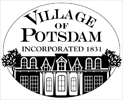replicas relojes suizos replique montre relpica uhren kaufen replicas de relojes replica uhren deutschland
BRIDGES AT POTSDAM
Before the first bridge was built at Potsdam in 1809, the Racquette was crossed by a raft just below the falls. It was usually tied to the west bank for that was where the few people lived. People coming from the east had to call across and someone would go across for them.

 In
1809, the first bridge was built on the side of the present one. This
one lasted until 1830 when a second one was built which lasted until
1849. The new one built in 1850 lasted until 1920. This is the iron
bridge many of us remember; a picture of it is in the Museum
collection. The present bridges were built in 1920.
In
1809, the first bridge was built on the side of the present one. This
one lasted until 1830 when a second one was built which lasted until
1849. The new one built in 1850 lasted until 1920. This is the iron
bridge many of us remember; a picture of it is in the Museum
collection. The present bridges were built in 1920. THE ACADEMY, 1810
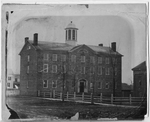 In
1810, Mr. Raymond erected a building on Union Street for a school and
place of worship. Church services were first held in Mr. Raymond’s own
home. First, for his own family and gradually increasing in members as
friends asked to join the Raymonds. The first teacher-minister was
engaged in January 1811, a Mr. James Johnson of Lynn, Massachusetts, a
graduate of Harvard. The two original letters written by B. Raymond to
hire Mr. Johnson are framed and in the Museum. In 1811, when services
were first held in the little new building, the group called themselves
‘St. Paul’s Society’. Later, this society having been disorganized,
‘Trinity Society’ was formed: John C. Clarkson, Horace Allen, Forrest
Morgan, Ezra Barnum, Samuel Partridge and Daniel Shaw, trustees. The
name was considered ‘too stylish’ for a group of Puritans, so the name
was changed to ‘The First Presbyterian Society’ on December 16, 1820.
Azel Lyman, Sewall Raymond, and Forrest Morgan were trustees.
In
1810, Mr. Raymond erected a building on Union Street for a school and
place of worship. Church services were first held in Mr. Raymond’s own
home. First, for his own family and gradually increasing in members as
friends asked to join the Raymonds. The first teacher-minister was
engaged in January 1811, a Mr. James Johnson of Lynn, Massachusetts, a
graduate of Harvard. The two original letters written by B. Raymond to
hire Mr. Johnson are framed and in the Museum. In 1811, when services
were first held in the little new building, the group called themselves
‘St. Paul’s Society’. Later, this society having been disorganized,
‘Trinity Society’ was formed: John C. Clarkson, Horace Allen, Forrest
Morgan, Ezra Barnum, Samuel Partridge and Daniel Shaw, trustees. The
name was considered ‘too stylish’ for a group of Puritans, so the name
was changed to ‘The First Presbyterian Society’ on December 16, 1820.
Azel Lyman, Sewall Raymond, and Forrest Morgan were trustees.THE CHURCHES, 1820-1969
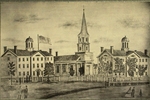
 In
1820, the Presbyterians decided to build a white wooden church on the
Gospel Lot at a cost of $4,500. This was in the center of the Park
where Clarkson’s Snell Hall is today. The frame was up on July 1st,
1821. The raising was a great event. An ample lunch was provided by
the people of the church with plenty of good liquor to wash it down.
Total abstinence was not yet considered a religious virtue. The
following story was related by the Rev. George R. Sawyer to William H.
Wallace Esq. right after the erection of the single tall timber. Ansel
Paine mounted to the top, more than 100 feet high, stood erect on the
end of the timber, swung a whiskey bottle around his head and then flung
it to the ground where it landed unbroken in the mud. He then, for a
moment, reversed his position, stood on his head on the end of the
single timber and finally descended to earth.
In
1820, the Presbyterians decided to build a white wooden church on the
Gospel Lot at a cost of $4,500. This was in the center of the Park
where Clarkson’s Snell Hall is today. The frame was up on July 1st,
1821. The raising was a great event. An ample lunch was provided by
the people of the church with plenty of good liquor to wash it down.
Total abstinence was not yet considered a religious virtue. The
following story was related by the Rev. George R. Sawyer to William H.
Wallace Esq. right after the erection of the single tall timber. Ansel
Paine mounted to the top, more than 100 feet high, stood erect on the
end of the timber, swung a whiskey bottle around his head and then flung
it to the ground where it landed unbroken in the mud. He then, for a
moment, reversed his position, stood on his head on the end of the
single timber and finally descended to earth.The white church was dedicated in February 1822 and used until 1853 when it was replaced by a brick church at a cost of $10,000. In 1867, this was sold to the State for $10,000 and incorporated in the new Potsdam Normal School, forming the central part. In 1868, the present church of Potsdam sandstone, Elm Street and Lawrence Avenue, was started. It was completed in 1872 at a cost of $47,000.
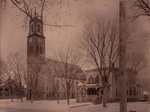
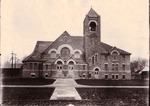 The
First Methodist Church was organized in 1821 and the white wooden
church built on the site of the present Fire Station. This served as
the church until 1860 when it was sold to the village for a firemen’s
hall. The steeple removed, the building remodeled and served until 1913
when the present building of brick was built. Incidentally, the Fire
Department was organized in 1823 and incorporated in 1831. In 1860, the
Methodists erected their second church, a brick one on the site of the
present church. The parsonage was built in 1882. This church became
too small and in 1903 the present structure of Gouverneur marble was
built.
The
First Methodist Church was organized in 1821 and the white wooden
church built on the site of the present Fire Station. This served as
the church until 1860 when it was sold to the village for a firemen’s
hall. The steeple removed, the building remodeled and served until 1913
when the present building of brick was built. Incidentally, the Fire
Department was organized in 1823 and incorporated in 1831. In 1860, the
Methodists erected their second church, a brick one on the site of the
present church. The parsonage was built in 1882. This church became
too small and in 1903 the present structure of Gouverneur marble was
built. The
Baptist Church was organized January 9, 1824. The present church is
the original building, with improvements being made from time to time.
It was built in 1858 at a cost of $5,000. It was of wood painted gray.
It was improved in 1875 at a cost of $2,500. The parsonage was built
between 1875 and 1878. The wooden structure has been covered with
asbestos shingles.
The
Baptist Church was organized January 9, 1824. The present church is
the original building, with improvements being made from time to time.
It was built in 1858 at a cost of $5,000. It was of wood painted gray.
It was improved in 1875 at a cost of $2,500. The parsonage was built
between 1875 and 1878. The wooden structure has been covered with
asbestos shingles.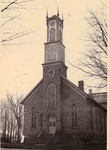
 The
Universalist Church was incorporated in October 2, 1825. The old white
church was built in 1835 (pictured left) and replaced by the church of
Potsdam sandstone in 1876 at a cost of $12,000 (pictured right). Services were
held until 1933 when a few remaining members voted to give the property
to the village, the building for a library, the land between the church
and town hall to be part of the new Civic Center. The church was
remodeled in 1934 when the Civic Center was built and the library moved
from Market Street location in 1935.
The
Universalist Church was incorporated in October 2, 1825. The old white
church was built in 1835 (pictured left) and replaced by the church of
Potsdam sandstone in 1876 at a cost of $12,000 (pictured right). Services were
held until 1933 when a few remaining members voted to give the property
to the village, the building for a library, the land between the church
and town hall to be part of the new Civic Center. The church was
remodeled in 1934 when the Civic Center was built and the library moved
from Market Street location in 1935.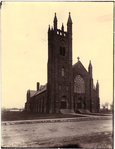
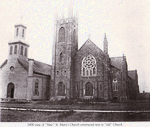 The
Roman Catholic Church first held services in 1832. The first mass was
said in the house of a Mr. Burk on Pierrepont Avenue. In 1841, a
dwelling house (12 Clinton Street) to which the name “St. Mary’s” was
given was purchased and used as a church. In 1857, Potsdam became an
independent parish and in 1859 the large gray wooden church was built at the corner of Lawrence Avenue and Clinton Street. The
present sandstone church was built in 1898, dedicated December 18, 1900;
redecorated and opened December 17, 1950. The brick parsonage was
built in 1866 and the present Rectory in 1918-19. The first resident
priest was Rev. James Keeveny about 1856.
The
Roman Catholic Church first held services in 1832. The first mass was
said in the house of a Mr. Burk on Pierrepont Avenue. In 1841, a
dwelling house (12 Clinton Street) to which the name “St. Mary’s” was
given was purchased and used as a church. In 1857, Potsdam became an
independent parish and in 1859 the large gray wooden church was built at the corner of Lawrence Avenue and Clinton Street. The
present sandstone church was built in 1898, dedicated December 18, 1900;
redecorated and opened December 17, 1950. The brick parsonage was
built in 1866 and the present Rectory in 1918-19. The first resident
priest was Rev. James Keeveny about 1856.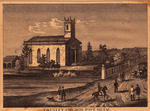
The first Episcopal services were held in Potsdam in 1818, the Rev. Amos Baldwin went on alternate Sundays to Ogdensburg and Waddington, and on Wednesdays to Russell, Canton, Potsdam, and Parishville. Similar service from Ogdensburg and Waddington until November 11, 1834 when Rev. Richard Bury became the first resident minister. He was here until 1837 and lived in the LeRoy home on LeRoy Street where the Merritt apartment now stands. On the 23rd of March, 1835, at a meeting held in the North Academy Building, the parish was organized under the name of Trinity Church. On the 10th of April, 1835, John C. Clarkson wrote to the proprietors as follows: “A few weeks ago we organized our Parish by the name of ‘Trinity Church, Potsdam’. I should now be pleased to receive from the Proprietors their written authorization to convey to the vestry, as a gratuity, all this part of Fall Island in the village of Potsdam lying south of the Turnpike, as a site for our Episcopal Church.”
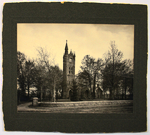 Trinity
Church was built in 1835. It was modeled after old Trinity Church in
New York which the Clarksons had attended. John C. Clarkson and
Augustus L. Clarkson were wardens. Vestrymen were David L. Clarkson,
Zenas Clark, Theodore Clark, Myron C. Munson, Noble Strong Elderkin,
Samuel Partridge, Frederick Miller Jr. and Aaron T. Hopkins. The church
was built of sandstone in the old slab and binder style. Only the
sides of the old church remain in the present edifice. The recessed
chancel was built in 1858. The chapel of Trinity Church was erected in
memory of Levinus Clarkson and his father with $10,000 left by Mrs.
Elizabeth Clarkson. The new facade was given by T.S. Clarkson and his
sisters and dedicated on February 26, 1886.
Trinity
Church was built in 1835. It was modeled after old Trinity Church in
New York which the Clarksons had attended. John C. Clarkson and
Augustus L. Clarkson were wardens. Vestrymen were David L. Clarkson,
Zenas Clark, Theodore Clark, Myron C. Munson, Noble Strong Elderkin,
Samuel Partridge, Frederick Miller Jr. and Aaron T. Hopkins. The church
was built of sandstone in the old slab and binder style. Only the
sides of the old church remain in the present edifice. The recessed
chancel was built in 1858. The chapel of Trinity Church was erected in
memory of Levinus Clarkson and his father with $10,000 left by Mrs.
Elizabeth Clarkson. The new facade was given by T.S. Clarkson and his
sisters and dedicated on February 26, 1886.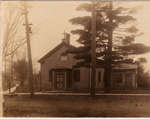 In 1837, the Catholic
Apostolic Church was organized. The church stood next to Mr. Dona’s
house, corner Maple Street and Pine Street where the gas station now
is. The church was built in 1843, enlarged in 1874, and torn down
sometime after December 1920 when the church was given up. A few
families of this church still live in Potsdam including Herbert Bicknell
and Bernetta Seeley Elliott. David Lewis invited two evangelists here
in 1837 when the church was formed. W.J. Seeley and W.F.B. Seeley were
prominent members. Noah Perrin was Chief Elder and acting Pastor until
his death in 1876.
In 1837, the Catholic
Apostolic Church was organized. The church stood next to Mr. Dona’s
house, corner Maple Street and Pine Street where the gas station now
is. The church was built in 1843, enlarged in 1874, and torn down
sometime after December 1920 when the church was given up. A few
families of this church still live in Potsdam including Herbert Bicknell
and Bernetta Seeley Elliott. David Lewis invited two evangelists here
in 1837 when the church was formed. W.J. Seeley and W.F.B. Seeley were
prominent members. Noah Perrin was Chief Elder and acting Pastor until
his death in 1876. The
Christian Science Church was organized in 1891. The first services
were in homes, including the home of M.V.B. Ives from 1896 to 1899 and
the home of Miss Julie Ettie Crane from 1899 until 1901. In 1901, the
church rented the Dayton House, corner Main and Pierrepont. It had
Reading Rooms from 1901 to 1919 over Stone’s Gallery, corner Market and
Munson Streets, where the National Grid office is now. The church
purchased the Dayton House in 1919 and held its first service September
7, 1919. In 1946, the present church was purchased from Julie Walling
and the first service held on Thanksgiving Day, 1947.
The
Christian Science Church was organized in 1891. The first services
were in homes, including the home of M.V.B. Ives from 1896 to 1899 and
the home of Miss Julie Ettie Crane from 1899 until 1901. In 1901, the
church rented the Dayton House, corner Main and Pierrepont. It had
Reading Rooms from 1901 to 1919 over Stone’s Gallery, corner Market and
Munson Streets, where the National Grid office is now. The church
purchased the Dayton House in 1919 and held its first service September
7, 1919. In 1946, the present church was purchased from Julie Walling
and the first service held on Thanksgiving Day, 1947.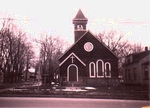 Three new
churches have made their appearance in Potsdam during the past 20
years. The Church of the Nazarene, corner Market and Cottage Streets,
was built in 1951 by Mose LaValley of Potsdam. Mr. LaValley was
seriously ill and made a promise that if he got well he “would repay God
by building a church”. He constructed the church entirely by himself
and donated it for the use of the Nazarenes. Services began June 10,
1951.
Three new
churches have made their appearance in Potsdam during the past 20
years. The Church of the Nazarene, corner Market and Cottage Streets,
was built in 1951 by Mose LaValley of Potsdam. Mr. LaValley was
seriously ill and made a promise that if he got well he “would repay God
by building a church”. He constructed the church entirely by himself
and donated it for the use of the Nazarenes. Services began June 10,
1951.
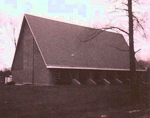 In 1963, the Emmanuel Baptist Church was built on the May
Road, near Haggarty Road. The first services were held in the spring of
1964.
In 1963, the Emmanuel Baptist Church was built on the May
Road, near Haggarty Road. The first services were held in the spring of
1964.The newest church in Potsdam is the Gloria Dei Lutheran Church, located on outer Elm Street. It was built in 1967-68 and was dedicated December 8, 1968.
SCHOOLS
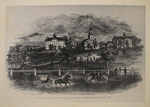
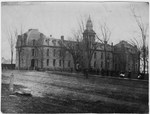 Let
us now return to the early 1800s and trace the growth of our schools
from the “Old Academy” on Union Street built in 1811. By 1825, this
building became too small and the first building of the St. Lawrence
Academy was built on the Literature Lot north of the white wooden
Presbyterian Church. This was of sandstone, the slab and binder type of
mason work. Ten years later, in 1835, the South Building of the
Academy was built. This building was used as teacher’s training. It is
recorded in history that no town showed more energy or industry in
promoting improvements than Potsdam. When the State decided to
establish a Normal School in this area, Potsdam was chosen as the site
because of the fine record the St. Lawrence Academy had made in teacher
training. The Academy buildings were sold to the state. The first
Normal School was built in 1867, and rebuilt in 1917. The Normal School
became Potsdam State Teachers College in 1942 and the college moved to
its Pierrepont Avenue campus in 1948 and that same year became part of
the State University system. The Normal School building on Park Street
was sold to Clarkson College and today houses the administration and
classrooms.
Let
us now return to the early 1800s and trace the growth of our schools
from the “Old Academy” on Union Street built in 1811. By 1825, this
building became too small and the first building of the St. Lawrence
Academy was built on the Literature Lot north of the white wooden
Presbyterian Church. This was of sandstone, the slab and binder type of
mason work. Ten years later, in 1835, the South Building of the
Academy was built. This building was used as teacher’s training. It is
recorded in history that no town showed more energy or industry in
promoting improvements than Potsdam. When the State decided to
establish a Normal School in this area, Potsdam was chosen as the site
because of the fine record the St. Lawrence Academy had made in teacher
training. The Academy buildings were sold to the state. The first
Normal School was built in 1867, and rebuilt in 1917. The Normal School
became Potsdam State Teachers College in 1942 and the college moved to
its Pierrepont Avenue campus in 1948 and that same year became part of
the State University system. The Normal School building on Park Street
was sold to Clarkson College and today houses the administration and
classrooms.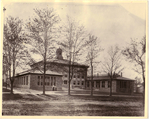 Clarkson
College was founded in 1896 by Miss Elizabeth, Miss Frederica, and Miss
Levinia Clarkson, in memory of their brother, Thomas S. Clarkson, who
was killed in a quarry accident in 1894. The college’s first building
“Old Main” was built of Potsdam sandstone in 1896. The college expanded
to the Clarkson estate on Maple Street in 1956 and has also constructed
a number of new facilities on Main Street.
Clarkson
College was founded in 1896 by Miss Elizabeth, Miss Frederica, and Miss
Levinia Clarkson, in memory of their brother, Thomas S. Clarkson, who
was killed in a quarry accident in 1894. The college’s first building
“Old Main” was built of Potsdam sandstone in 1896. The college expanded
to the Clarkson estate on Maple Street in 1956 and has also constructed
a number of new facilities on Main Street.Articles about the local elementary and secondary schools written by Grace and Ethel French and about the St. Lawrence Academy written by me are on file in the Museum.

